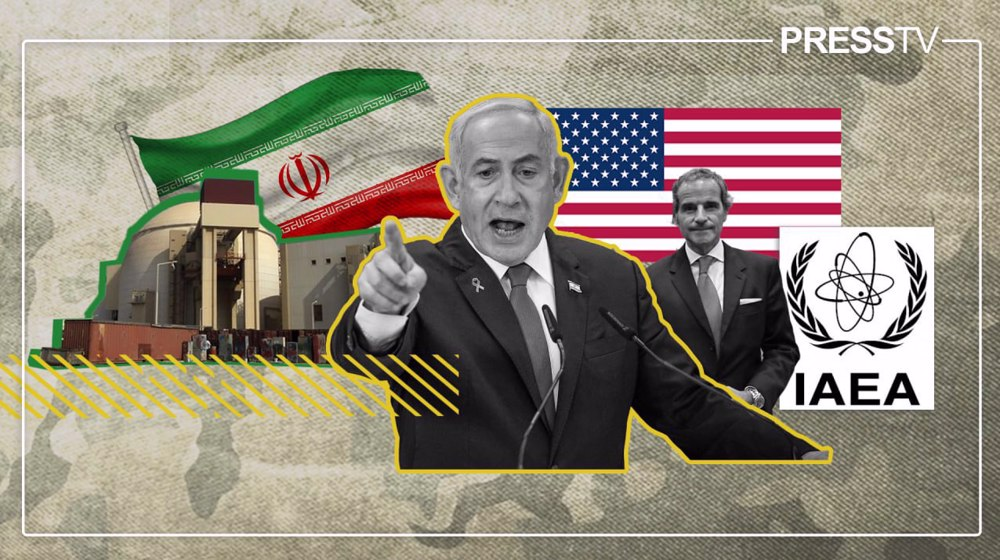
By Humaira Ahad / PRESS TV
For over two decades, the Israeli regime has waged a relentless and multifaceted campaign against the Islamic Republic of Iran’s peaceful nuclear program.
Employing cyberwarfare, sabotage, aerial strikes, and the targeted assassination of nuclear scientists, Tel Aviv has tried everything to obstruct Iran’s legal and legitimate efforts to harness nuclear energy under internationally recognized safeguards.
As a signatory to the Non-Proliferation Treaty (NPT), Iran has consistently asserted that its nuclear program is entirely peaceful and remains under the strict supervision of the International Atomic Energy Agency (IAEA).
In 2023 and 2024 alone, Iranian nuclear facilities underwent more than 427 inspections—an “unprecedented” level of scrutiny in the history of global nuclear oversight, as admitted even by UN officials.
Yet despite this transparency, the IAEA has repeatedly aligned itself with the Israeli regime, enabling a politically driven campaign that undermines Iran’s sovereign right to peaceful nuclear advancement.
IAEA: Partner in aggression
The latest wave of unprovoked and unlawful aggression against Iran’s peaceful nuclear program began on June 13, when Israeli fighter jets targeted Iran’s central uranium enrichment facility at Natanz, followed by an attack on the Arak nuclear reactor days later.
Behrooz Kamalvandi, spokesperson for the Atomic Energy Organisation of Iran (AEOI), rebuked the IAEA for its “dangerous and deliberate silence,” following the Israeli attacks.
“We wrote multiple letters to Director-General Rafael Grossi warning of these threats, but they remained unanswered,” Kamalvandi stated following the aggression.
Iran’s nuclear agency, he said, considers the IAEA's silence “to be a form of collaboration with the Zionist regime.”
Kamalvandi said Grossi has been echoing Israeli narratives in international forums and interviews. “The IAEA’s failure to hold Israel accountable has irreparably damaged its credibility. They have surrendered the agency’s independence to geopolitical coercion.”
In the following days, Israel’s aggression escalated further, in brazen violation of international law.
On June 19, Israeli occupation forces carried out simultaneous attacks on multiple sites, including the Natanz facility and the Khondab (Arak) heavy water reactor.
Just three days later, on June 22, American B-2 bombers violated Iranian airspace, targeting sensitive nuclear facilities at Fordow, Natanz and Isfahan in what was a US-Israel coordinated aggression. On June 23, Israel struck again, targeting the access roads to Fordow.
In response to the “premediated conspiracy” by the IAEA, Iran has announced plans to initiate legal proceedings against the IAEA Director. It says the June 12 IAEA report falsely accusing Iran of non-compliance was instrumental in Israel’s war of aggression on Iran.
Iran’s parliament (Majlis) on Wednesday approved a bill to suspend Tehran’s cooperation with the IAEA. Lawmakers described the IAEA actions as a betrayal of its charter and a direct enabler of aggression against a sovereign member of the Non-Proliferation Treaty (NPT).
Iran’s foreign ministry stated that Grossi, “betrayed the non-proliferation regime”, transforming the IAEA into “a partner to an unjust war of aggression.”
Mohammad Eslami, head of the AEOI, echoed that stance, warning: “When this war ends, we will hold IAEA Director-General Rafael Grossi fully accountable for legitimising military strikes on safeguarded facilities.”
IAEA’s complicity and double standards
One of the most underreported dimensions of this war has been the role of the IAEA.
Far from being a neutral arbiter, the UN atomic agency has repeatedly allowed itself to be used as a political tool by the United States and the Israeli regime.
Secret documents released by Iran show that the IAEA Director coordinated with Israel and advanced claims against Iran based on fabricated intelligence. On multiple occasions, he raised concerns about “undeclared sites” based solely on documents that are doctored and misleading.
“The IAEA is supposed to be impartial,” said Kamalvandi. “Their job is to monitor, not to act as a political weapon,” the spokesperson asserted.
Even as Iran allows IAEA inspectors unprecedented access, the agency has remained mute on Israel’s violations of international laws. Its silence on the regime’s aerial and cyber attacks against Iran’s safeguarded nuclear facilities is collusion by the international agency.
Experts say that this one-sided scrutiny has deeply harmed the credibility of the global non-proliferation regime. It creates a two-tier system: one where Western-backed nuclear powers like Israel act with impunity, and another where sovereign nations like Iran are perpetually vilified despite compliance.
The Islamic Republic has declared that it is going to launch an international legal case against Grossi, holding him personally accountable for issuing a faulty, politically motivated report.
Iran maintains that the IAEA has abandoned its neutrality, reduced to a political instrument for Israel and the US, and no longer functions as a watchdog, but an enabler of unlawful aggression.
Digital battlefield: US-Israel cyber terrorism
Israel’s war on Iranian nuclear facilities began in the shadows of cyberspace. Among the earliest acts of aggression by the Zionist regime was the deployment of the Stuxnet worm, a joint US-Israeli cyber weapon launched under the code name “Operation Olympic Games.”
Conceived during the George W. Bush administration and escalated under Barack Obama, the operation aimed to delay Iran’s nuclear progress by sabotaging its centrifuges.
As Bush met Obama in the White House days before his inauguration, the outgoing US president urged his successor to preserve the Olympic Games classified programs. Obama acted on the advice.
“If the Olympic Games failed, Obama told aides, there would be no time for sanctions and diplomacy with Iran to work. Israel could carry out a conventional military attack, prompting a conflict that could spread throughout the region,” The New York Times reported at the time of the Stuxnet operation against Iran.
The Stuxnet malware specifically targeted Siemens industrial control systems at Natanz, causing the centrifuges to spin out of control while falsely reporting normal activity to technicians. The worm destroyed around 1,000 centrifuges in operation.
Michael V. Hayden, the former chief of the CIA, once described it as “the first attack of a major nature in which a cyberattack was used to effect physical destruction.”
Although Stuxnet was intended to be covert, its discovery in 2010 led to widespread media coverage and global condemnation.
Israel’s broader cyber terrorism
From 2010 onward, Iran’s nuclear infrastructure was repeatedly targeted by a series of malware attacks. Among them were the Stars virus, Duqu, and Flame, all of which were believed to originate from the same US-Israeli cyberwarfare nexus.
Cybersecurity experts revealed that Duqu and Stuxnet were likely written by the same authors and based on the same code.
Duqu's purpose was to gather intelligence data from entities, such as industrial control system manufacturers, to more easily conduct future attacks.
A Washington Post investigation published nearly a decade ago, citing unnamed Western officials familiar with the operation, reported that the espionage malware Flame (2012) was developed by the US-Israel partnership to gather intelligence aimed at disrupting Iran’s nuclear program.
Israeli officials made their support for the terrorist operations clear.
“Anyone who sees the Iranian threat as a significant threat – it's reasonable [to assume] that he will take various steps, including these, to harm it,” stated Israel’s then-Vice Prime Minister Moshe Yaalon in 2012.
Israel’s covert explosions and drone attacks
The cyberwar was combined with a campaign of physical sabotage. On July 2, 2020, an explosion hit the Natanz nuclear facility. AEOI said the blast at the nuclear facility in central Iran was an act of sabotage by Israel.
In April 2021, a cyberattack affected the electricity distribution network at Natanz. AEOI condemned the assault as an act of terrorism and urged the international community and the IAEA to take decisive action, only to be met with deafening silence.
On June 23, 2021, a quadcopter attempted an attack on a nuclear facility near Tehran. The attempt was successfully thwarted, causing no structural damage to the site.
In October 2024, Israeli cyber units launched a wide-ranging offensive against Iranian nuclear infrastructure.
Abolhassan Firouzabadi, former head of Iran’s cybersecurity, said that the attacks caused measurable disruption but emphasized that Iran recovered swiftly.
“We bounced back quickly,” he said. “These assaults are more psychological warfare than true strategic victories.”
On October 26 last year, Israel attacked military sites in Tehran, Ilam, and Khuzestan provinces. However, Iranian air defence units successfully intercepted several drones and missiles, mitigating the overall impact.
Deafening silence and complicity
Iran has consistently condemned these terrorist acts as flagrant violations of international law. Yet global institutions have largely remained mute.
The United Nations, on its part, has failed to issue any resolution condemning Israel’s actions. The IAEA, whose mandate is to ensure the peaceful use of nuclear energy, has not issued any substantive response.
“Not only has the IAEA failed to protect us—it has emboldened our enemies,” Kamalvandi asserted.
While Iran’s peaceful nuclear program remains one of the most heavily monitored in the world, Israel, an undeclared nuclear power with an estimated arsenal of 80–90 warheads, faces no scrutiny.
Despite the relentless campaign against the Islamic Republic, its response has been marked by resilience, restraint, and strategic clarity. Iran has insisted that the country will not pursue nuclear weapons, citing religious and ethical prohibitions.
“Our goal is technological self-reliance,” stated AEOI chief Mohammad Eslami. “We will not be bullied into abandoning our rights.”
Iran’s nuclear facilities remain under IAEA safeguards, as Iran consistently cooperates with inspections, even as the findings were unlawfully politicised and weaponised by the US and Israel. In this case, the Atomic Agency became a facilitator of injustice, abandoning its fundamental obligation of impartiality.
However, despite cyberattacks, airstrikes, and diplomatic pressure, Iran continues to expand its peaceful nuclear infrastructure, developing civilian technologies, including nuclear medicine, to demonstrate its resilience and self-reliance in the face of mounting challenges.

